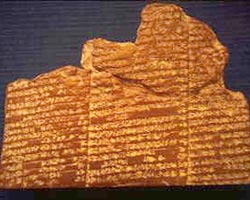| Site Map | Contacts | Links | Newsletter | |
History:
Sumerian
The Sumerians were the oldest known civilization with city-states, fortified towns and the development of writing called cuneiform which is Latin for "wedge-shaped forms." Sumerian language is different from all other languages. It started out as pictograms. The Sumerians invented the sexagesimal system which counts by 60. This is where we get our 60 seconds in a minute and 60 minutes in an hour. The beginning of urbanization starts with the Uruk Period (3500 BC). The Early Dynastic I of the Sumerians started around 2900 BC after the great flood. Then came the Early Dynastic II and III. Different cities rose to power during these times. The Akkadian Empire rose to power with Sargon from 2334 to 2279. Then the Third Dynasty of Ur rose to power around 2100 BC. Ur fell in 2004 BC. Then the Dynasty of Isin and Larsa rose to power.
 |
Sumerian Flood Story Tablet at U of Penn Museum (replica) |
Sumerian Literature
One major story that parallels the Bible is the Sumerian Flood Story that is very similar to Noah’s flood story (Genesis 6-9). Also the Sumerian King List is similar to the genealogies of Genesis 5. The Sumerian King List (SKL) also mentions a great flood. It tells of the kings who ruled before and after the great flood. There are also creation stories like the Song of the Hoe, and Enki and Ninmah. Eridu Genesis parallels Genesis by telling of the creation of man and animals, antediluvian cities and their rulers, and then the great flood. In Enmerkar and the Lord of Aratta Sumer is of one language until the Lord of Eridu estranged their tongues which is similar to the Tower of Babel story.
 |
Sumerian King List, called the Weld-Blundell prism at the Ashmolean Museum. |
Akkadian Empire
The Akkadian Empire rose to power with Sargon from 2334 to 2279. This is the first true empire in Mesopotamia. The legend of Sargon of Akkad or Agade in Sumerian, tells how Sargon was was born of a priestess who put him in a basket in the river (similar to the story of Moses). A gardener found and raised him under Istar's protection. Sargon grew up to become the cupbearer to the King of Kish. He then overthrew the king, and set up his own kingdom at Akkad.
The last King of the Akkad empire was Naram-Sin, which means "lover of Sin" the moon goddess. There is the "Curse of Agade" because of his evil deeds.
 |
 |
| Princess's Headdress | High Priestess of Ur |
Third Dynasty of UR
The Third Dynasty of Ur rose to power around 2100 BC. Ur fell in 2004 BC. Ur was not called Ur of the Chaldeans until the time of the Neo-Babylonian empire. Abraham is was from Ur, but there was another Ur up North near Haran.
First Dynasty of Babylon
The First Babylonian Dynasty started about 1900 BC. The peak of its power was with Hammurabi (1792-1750). He is famous for his code, the Code of Hammurabi because the laws are very similar to the laws of Moses. One of the differences in Hammurabi’s Code is that if you were rich you could buy your way out of trouble even if you killed someone. The book Law Collections from Mesopotamia and Asia Minor by Martha Roth is an excellent resource of translations of ancient laws.
 |
 |
| Hammurabi receives the blessing of the sun god Shamash. | Law Collections from Mesopotamia and Asia Minor by Martha Roth. |
Akkadian Literature
With the decline of Sumerian, Akkadian became the lingal franca in the second millennium BC until the time of the Persians when Aramaic was the official language. Akkadian is an Eastern Semitic language. There are number of parallel stories, words, and phrases between Akkadian and Hebrew. Enuma Elish is an Akkadian creation story with some parallels with Genesis 1-2. The Adapa Story is similar to Adam. Atra-Hasis is very similar to the first 11 chapters of Genesis. There is a great flood. Also in the Gilgamesh.
